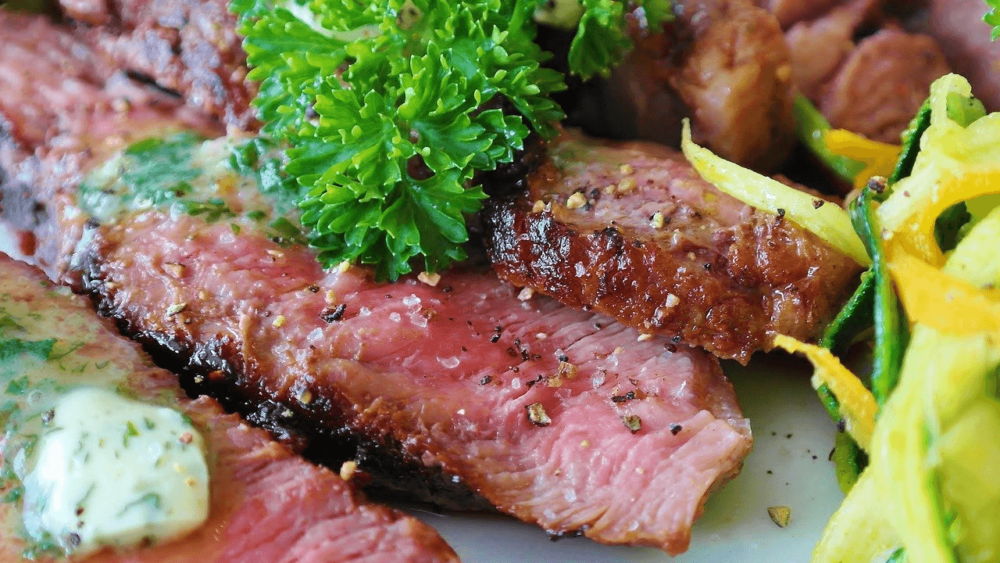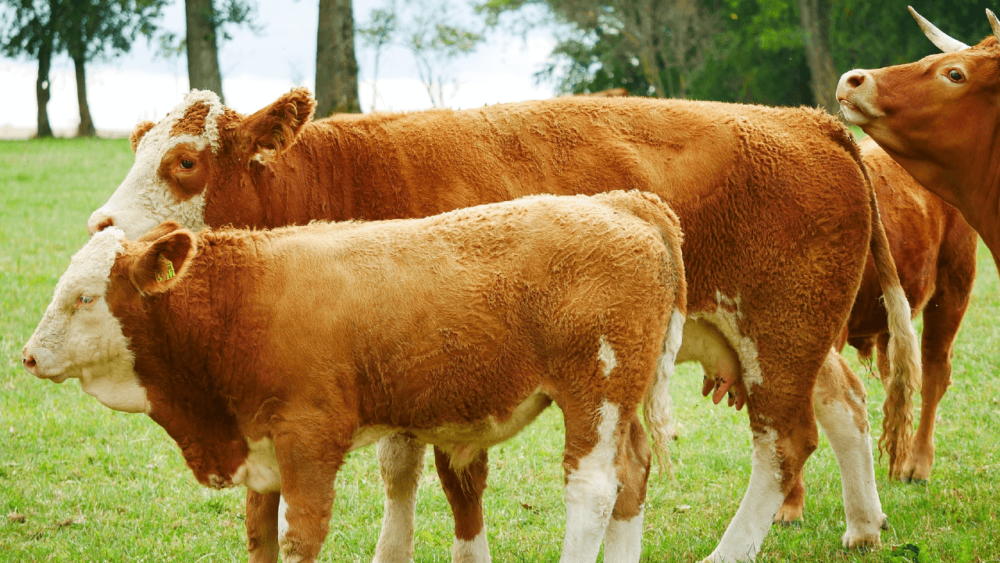You may have noticed that beef prices are rising. From hamburgers to steak, the price per pound, or cut, is increasing.
When it comes to sustainable food, there are many factors to juggle. This becomes more pronounced when you have a large family and is influenced by where you live and the local options you have.
For me, it’s an ongoing balancing act. I have five kids and that means we eat, a lot. It’s a lot less pronounced in the cost to purchase sustainable beef for a family of 2 or 3 than it is for a family of 7. If you are trying to decide what factors are the most critical to your family’s needs, it’s important to understand the difference between grass-fed, grain-finished, and raising your own cow.
Grass-Fed Versus Grain-Finished Beef
Organic foods have become a very hot trend lately. That’s because of rising awareness of where our food comes from and how it’s grown or raised. When it comes to beef, there are many types of ways that beef cows are raised.
They can be raised on pasture grass or grazed in the mountains and on local vegetation. That’s how most of the beef cattle in my part of the U.S. are raised. They go up to the mountains in the spring and are fed locally-grown hay in the winter.
This is called grass-fed. But, there are also cows that are considered grain-finished. In fact, most grain-finished cows are grass-fed for the majority of their lives.
- Grain finished cattle take 12 months to finish (reach full weight)
- Grain finished cattle yield about 45% of the live weight in final pounds of meat
- Grain-finished beef is between $1.60-2.60 a pound, depending on whether processing fees are included
What Grain-Finished Beef Means
Grain-finished cows spend the majority of their lives eating grass and foraging. But, in the last 4-6 months before the cattle are butchered, they are sent to a feedlot to be “finished.” Finishing is the process of finishing the bulking up of cattle to full-size before butchering it.
Grain-finished refers to cattle that are sent to feedlots to fatten up. Feedlots finish cattle up by feeding them a very specific diet that comprises hay, grain, and other food. Sometimes this includes food intended for human consumption, like beets that weren’t sold or didn’t make the cut because they grew into non-standard shapes.
In this manner, cows provide a way to up-cycle much food that would have been thrown away into landfills. And, don’t think they are just eating anything. It’s in the feedlot’s best interest to keep the cows healthy so they vigorously monitor what they eat.
Plus, many consumers think that grain is bad for cattle. But, remember that corn, although a grain, is a type of grass.
Defining Grass-Fed Beef
Grass-Fed beef comes from cattle that are raised on grass. It can refer to cows that fatten entirely on hay and forage but is also used for cows that are fattened on a feedlot. Grass-finished cows refer only to cows that were 100% raised on grass and forage plants.
Typically grass-finished cows take 2-3 years to fully grow, but grain-finished cows only take about 18-20 months. It is a lot more costly to raise fully grass-fed cattle. It takes acres more grass to feed each animal. And, farmers can’t rotate a new batch of beef cows through as frequently. Corn is cheaper to grow and higher-calorie than grass to grow.
It’s just more expensive to raise a grass-finished cow than a grain-finished one. That’s why grass-finished beef is more expensive in the store.
- Grass finished cattle take 24-36 months to finish (reach full weight)
- Grass finished cattle yield about 35% of the live weight in final pounds of meat
- Grass finished beef is $4-6 more per pound than grain-finished beef
The Nutritional Difference Between Grain and Grass Finished Cattle
Texas A&M has completed the only two studies on the nutritional differences in grain-finished versus grass-finished beef. They found that there was essentially no difference. Grass-finished had higher omega 3, but grain-finished had higher omega 6 fatty acids. And grain-finished had a little more fat marbling.
But, the difference is so minimal, it will take a lifetime of eating beef to measure the differences. And, since most cows raised in the United States live most of their lives eating pasture grass and hay, it really isn’t about the quality of life for the cows.
For now, whether you choose grass-finished or grain-finished, you are choosing healthy meat for your family. Still, I acknowledge that not all types of forage plants are the same and different grasses have various nutritional components.
But, the only way to control those fine details is to raise your own beef cow.
Local or Shipped Beef
When considering your food source, the distance it traveled makes a difference. Food that travels far has an ecological cost from the shipping, trucking, and storage of it.
One of the delights of our modern world is being able to buy seafood in a land-locked area. But, when possible, if we consume local food, it makes a big impact on the world. Beef sold in big box grocery stores often travels across the country, sometimes from Canada or Mexico, to get to your store. There isn’t anything wrong with that.
But, for many people, sourcing local meat provides a way to contribute to their local community and reduce the carbon footprint of their beef. For some, this includes raising their own cow each year.
The issue has only become more pronounced post-Covid-19. In addition to trucking shortages, processing plants have closed, completely or in part, across the country. It is more difficult to find butchers locally in many areas.
In 2020 and 2021, many farmers struggled to find processing plants that could process their beef. Many were shut down temporarily, working partial shifts, or extremely short-handed due to Covid-19 regulations.
As you consider whether or not you raise your own beef cow, make sure that you can secure the services of a local butcher and don’t wait to get placed on their waiting list. This will make butchering your cow a lot less stressful for you!
Time to Raise a Cow?
While considering whether or now you want to raise your own cow, consider how much time and space you have. There are many options that fit every lifestyle. A fully, hand-on approach would mean that you raise your cow.
You provide the housing, fields, hay, and any care the cow needs. This will take more time because you are fully involved. But, it is ideal for those who love being involved and love the rewards of raising and caring for an animal.
Raising your own beef cow, especially if you already have the land to support grazing, can be less costly option than purchasing a finished cow from a local farmer. If you have the land, you can save on much of the feed costs. But, you will still have other costs such as vaccines and potential vet bills.
Purchasing a Cow Locally
Or, you can purchase a cow from a local farmer. In most states, a cow must be purchased prior to butchering. The cow is then taken to the butcher and you receive the whole or half cow that you purchased.
It’s a slight nuance, but most states don’t allow farmers to butcher their cattle and then sell the butchered meat.
Purchasing or raising a cow is different than purchasing from the store. You don’t get to choose specifically the quantity and types of beef you purchase. Instead, you get a certain amount of all types of beef. It usually means you pay more for ground beef, but quite a lot less for premium steak cuts.
Conclusion
When deciding whether or not to raise your own beef cow, purchase one locally, or purchase from a grocery store, there are many aspects to consider. While all of these various benefits are important, each family must determine what’s feasible and best for them.
You may also want to learn about the nutritional needs of cows and their salt and mineral needs.
Recommended Cattle Supplies (And Dairy Supplies)
This list contains affiliate products. Affiliate products do not cost more but helps to support BestFarmAnimals and our goal to provide farm animal owners with accurate and helpful information.
This shelter is pretty easy to put together and it shelters a good number of cows. It’s sturdy and can withstand our high winds and heavy snows. And it’s cheaper than a barn and easier to build.
Colostrum is critical for calves. If you aren’t able to get some from your cows, this is a quality supplemental colostrum.
Probiotic for cattle with digestion issues in a oral tube. It works for other ruminants and is safe for goats, but is formulated especially for cattle.
A halter to lead Bessie around. This show halter also works for kids showing for 4H.
All Stock Feed is on Amazon, but you’ll pay less if you find it at your local feed store. It’s a great feed for cattle.
Electrical rope for your fencing. This keeps cattle in, but goats, alas- not so well.
Dairy Cow Recommended Supplies
Disposable towels or wet wipes are the first step in cleaning the udders.
Teat Dip and a dip cup are essential for keeping your milk clean. It lasts a while. Mine usually lasts a year to a year and a half.
I use a stainless steel bucket when I milk because it’s easy to clean and carry. These are my preferred milk filters and I use them for cow and goat milk.
This large jar funnel stays much more stable than regular funnels and can handle larger milk volumes.
I like this grain feeder while milking and use this size for the cows and goats being milked.
Balm ointment for sore udders. This cream is popular for people but formulated and created for cows’ udders.
Mastitis Test detects mastitis.




